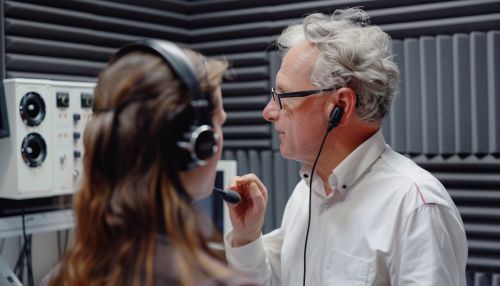Pure tone audiometry
Introduction
Pure tone audiometry is a key diagnostic tool used in audiology to evaluate an individual's hearing sensitivity. This method involves the use of pure tones, which are sounds with a single frequency, to determine the faintest tones a person can hear at various frequencies. The results are plotted on an audiogram, which provides a visual representation of a person's hearing thresholds. Pure tone audiometry is essential for diagnosing hearing loss, determining its severity, and guiding appropriate interventions.
History
The development of pure tone audiometry can be traced back to the early 20th century. Initially, tuning forks were used to assess hearing, but these were eventually replaced by electronic audiometers. The invention of the audiometer by Harvey Fletcher and his colleagues at Bell Telephone Laboratories in the 1920s marked a significant advancement in audiology. The first commercial audiometer, the Western Electric 1-A, was introduced in 1922, revolutionizing the way hearing assessments were conducted.
Principles of Pure Tone Audiometry
Pure tone audiometry is based on the principle of measuring hearing thresholds at different frequencies. The test typically covers frequencies ranging from 250 Hz to 8000 Hz, which are crucial for understanding speech. The audiometer generates pure tones at specific frequencies and intensities, which are presented to the patient through headphones or insert earphones. The patient indicates when they can hear the tone, and the threshold is recorded.
Audiometer Components
An audiometer consists of several key components:
- **Oscillator:** Generates pure tones at various frequencies.
- **Attenuator:** Adjusts the intensity of the tones.
- **Transducer:** Converts electrical signals into sound waves, typically through headphones or insert earphones.
- **Response Button:** Allows the patient to indicate when they hear a tone.
Test Procedure
The pure tone audiometry test is conducted in a sound-treated room to minimize background noise. The procedure involves several steps:
Preparation
1. **Patient History:** Collecting relevant medical and hearing history. 2. **Otoscopy:** Examining the ear canal and eardrum to ensure there are no obstructions or infections.
Air Conduction Testing
Air conduction testing evaluates the entire auditory pathway, from the outer ear to the auditory cortex. The procedure involves: 1. **Placement of Headphones:** Ensuring a proper fit to avoid sound leakage. 2. **Presentation of Tones:** Starting at a frequency of 1000 Hz, tones are presented at varying intensities. 3. **Threshold Determination:** The lowest intensity at which the patient can hear the tone 50% of the time is recorded.
Bone Conduction Testing
Bone conduction testing bypasses the outer and middle ear by directly stimulating the cochlea through a bone vibrator placed on the mastoid bone. This helps differentiate between conductive and sensorineural hearing loss. The procedure involves: 1. **Placement of Bone Vibrator:** Ensuring proper contact with the mastoid bone. 2. **Presentation of Tones:** Similar to air conduction testing, but using the bone vibrator.
Interpretation of Results
The results of pure tone audiometry are plotted on an audiogram, which displays hearing thresholds across different frequencies. The audiogram provides valuable information about the type and degree of hearing loss.
Types of Hearing Loss
- **Conductive Hearing Loss:** Characterized by a gap between air and bone conduction thresholds, indicating an issue in the outer or middle ear.
- **Sensorineural Hearing Loss:** Both air and bone conduction thresholds are elevated, indicating a problem in the inner ear or auditory nerve.
- **Mixed Hearing Loss:** A combination of conductive and sensorineural components.
Degree of Hearing Loss
Hearing loss is categorized based on the average hearing threshold levels:
- **Normal Hearing:** 0-25 dB HL
- **Mild Hearing Loss:** 26-40 dB HL
- **Moderate Hearing Loss:** 41-55 dB HL
- **Moderately Severe Hearing Loss:** 56-70 dB HL
- **Severe Hearing Loss:** 71-90 dB HL
- **Profound Hearing Loss:** >90 dB HL
Clinical Applications
Pure tone audiometry is widely used in various clinical settings for different purposes:
Diagnostic Audiology
Pure tone audiometry is essential for diagnosing hearing disorders, including:
- **Presbycusis:** Age-related hearing loss.
- **Noise-Induced Hearing Loss:** Resulting from exposure to loud sounds.
- **Ototoxicity:** Hearing loss due to medications or chemicals.
Hearing Aid Fitting
The results of pure tone audiometry guide the selection and fitting of hearing aids. The audiogram helps audiologists determine the appropriate amplification needed for different frequencies.
Occupational Health
Regular pure tone audiometry is conducted in occupational health settings to monitor the hearing of individuals exposed to noise in the workplace. This helps in early detection and prevention of noise-induced hearing loss.
Limitations
While pure tone audiometry is a valuable tool, it has certain limitations:
- **Subjective Nature:** The test relies on patient responses, which can be influenced by factors such as attention and motivation.
- **Limited Frequency Range:** Standard pure tone audiometry tests frequencies up to 8000 Hz, potentially missing high-frequency hearing loss.
- **Environmental Factors:** Background noise and improper headphone placement can affect test accuracy.
Advances and Future Directions
Recent advancements in audiometry include the development of automated audiometers and computer-based testing, which offer increased accuracy and efficiency. Research is ongoing to expand the frequency range tested and to develop objective measures of hearing sensitivity.


See Also
References
- To be added.
